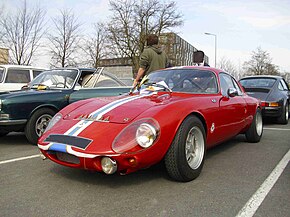René Bonnet Djet

The René Bonnet Djet, also Matra Bonnet Djet , was a sports car that was built by Automobiles René Bonnet between 1962 and 1964 .
Development history
In 1961 the long-term partnership between René Bonnet and Charles Deutsch separated . The two French had been operating under the company name Deutsch & Bonnet since 1932 and, in addition to road vehicles, developed successful racing cars, the DB HBR , the DB HBR4 and the DB HBR5 . After the separation, René Bonnet founded his own company - Automobiles René Bonnet.
The first separate development was the Djet. Bonnet and Deutsch had worked closely with Panhard in the 1950s and equipped their own developments with their technology. Apart from economic problems, the expiry of the delivery contract between Panhard and Deutsch & Bonnet was one of the reasons for the separation of the two partners. While Charles Deutsch was able to conclude a new agreement with Panhard, Bonnet had to seek new partnerships. He found this at Matra and Renault . Bonnet was able to win the then Matra owner Jean-Luc Lagardère for financial support for a new vehicle project and convince the Renault board of directors to supply the suspension, drive and engine technology.
As one of the first mid-engine sports cars to be built in series , the Djet is also significant in terms of automotive history. The chassis consisted of a central tubular frame, a grid structure made of square tubes. The slim body, tapering flat towards the rear, was made of plastic and was manufactured by a subsidiary of Matra. The opening rear window, which allowed easy access to the engine, was unusual. The 4-cylinder Gordini in - line engine developed 94 hp (69 kW) and accelerated the vehicle to up to 190 km / h. All four wheels were individually suspended via double wishbones with two coil springs and two shock absorbers each. The weak point was the four-speed transmission from the Renault Estafette , which was developed for a delivery van and was unsuitable for a sports car. It was difficult to switch and prone to defects.
198 chassis were built by 1964, 190 road cars and 8 racing chassis. However, these were too few copies to be profitable for Bonnet. Since Bonnet still had to bear old debts from the time of Bonnet & Deutsch, he accepted an offer from Lagardère in 1964 and sold his company to Matra. There the model was revised several times and sold as Matra Djet until 1968 . It was followed by the Matra 530 with a Ford engine.
Racing history
The Djet was driven between 1962 and 1965, but almost exclusively reported and used by the works team. The first race was in the 1000 km race at the Nürburgring in 1962 , which Jean Vinatier and Gérard Laureau finished in nineteenth overall. This resulted in a class victory right from the start, as the team crossed the finish line as the winner in the prototype class up to 1-liter displacement. For almost all French manufacturers, the Le Mans 24-hour race was and is of particular importance. In 1962 four Djets were supposed to enter the race. Bernard Consten and José Rosinski in the car with the starting number 46. Robert Bouharde and Jean Vinatier in the car with the number 49, and Jean-Claude Vidilles and Vinatier in the number 61. The Djet 2 Spider by Paul Armagnac and Laureau was a special form . A car failed to start after a training accident. Nevertheless, there was another class win, this time by Consten and Rosinski; the spider also finished.
This was followed by another class win by Vinatier in 1962 at the Trophée d'Auvergne and a second place in the registered racing class at the 1000 km race in Paris . In this race, Paul Armagnac had a fatal accident in a jet.
The successes in 1962 in the races for the sports car world championship in 1963 and 1964 could no longer be repeated.
